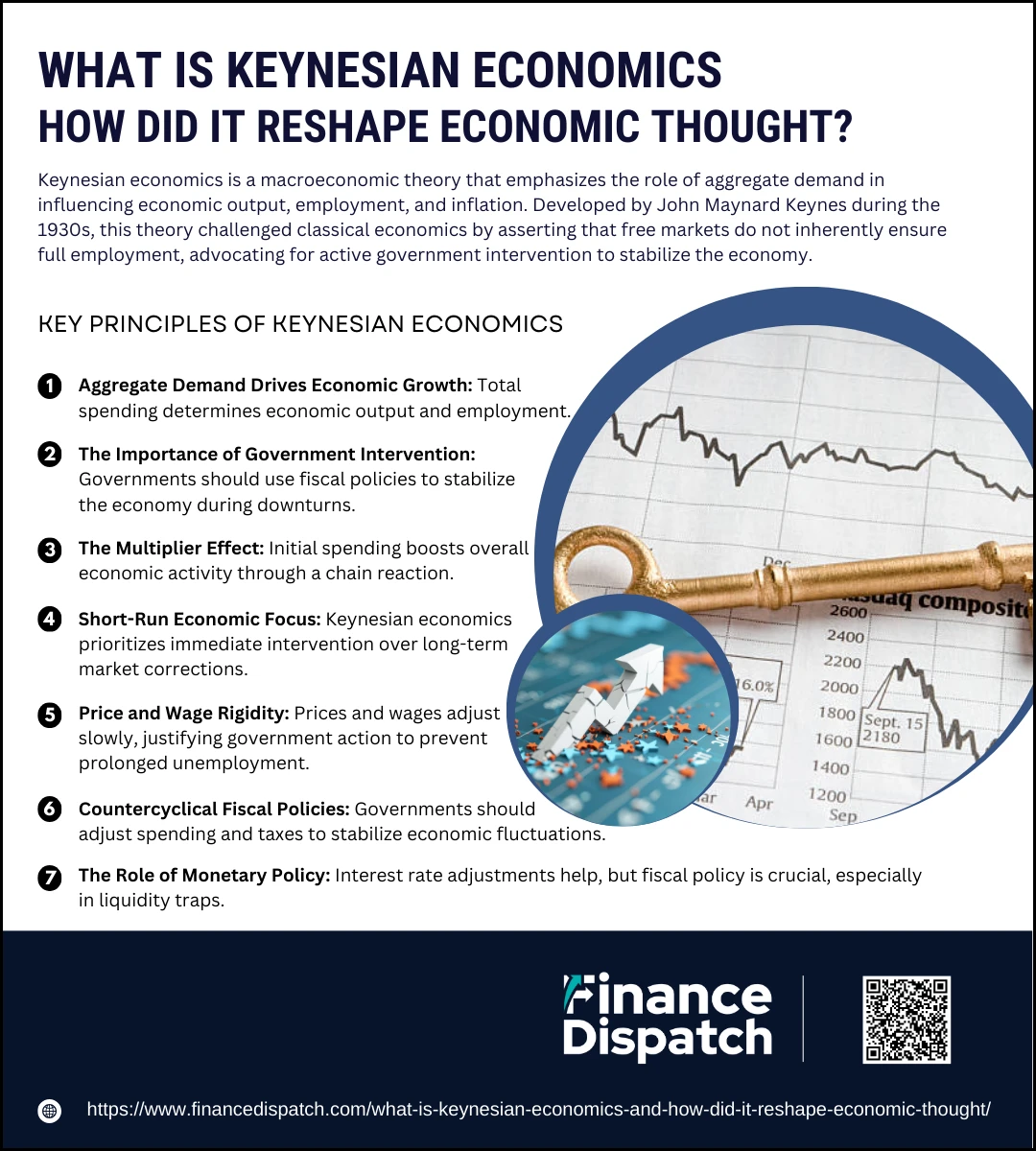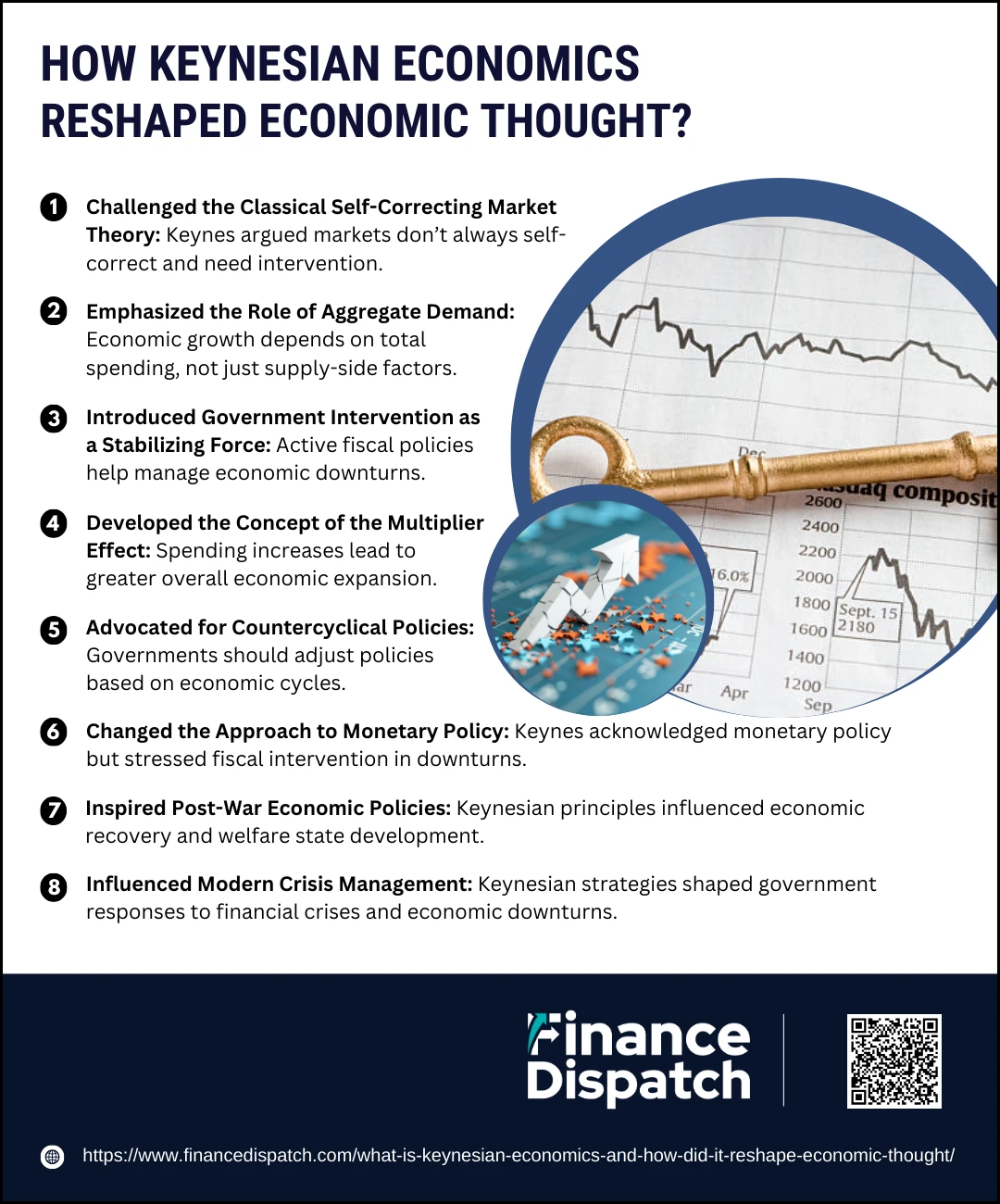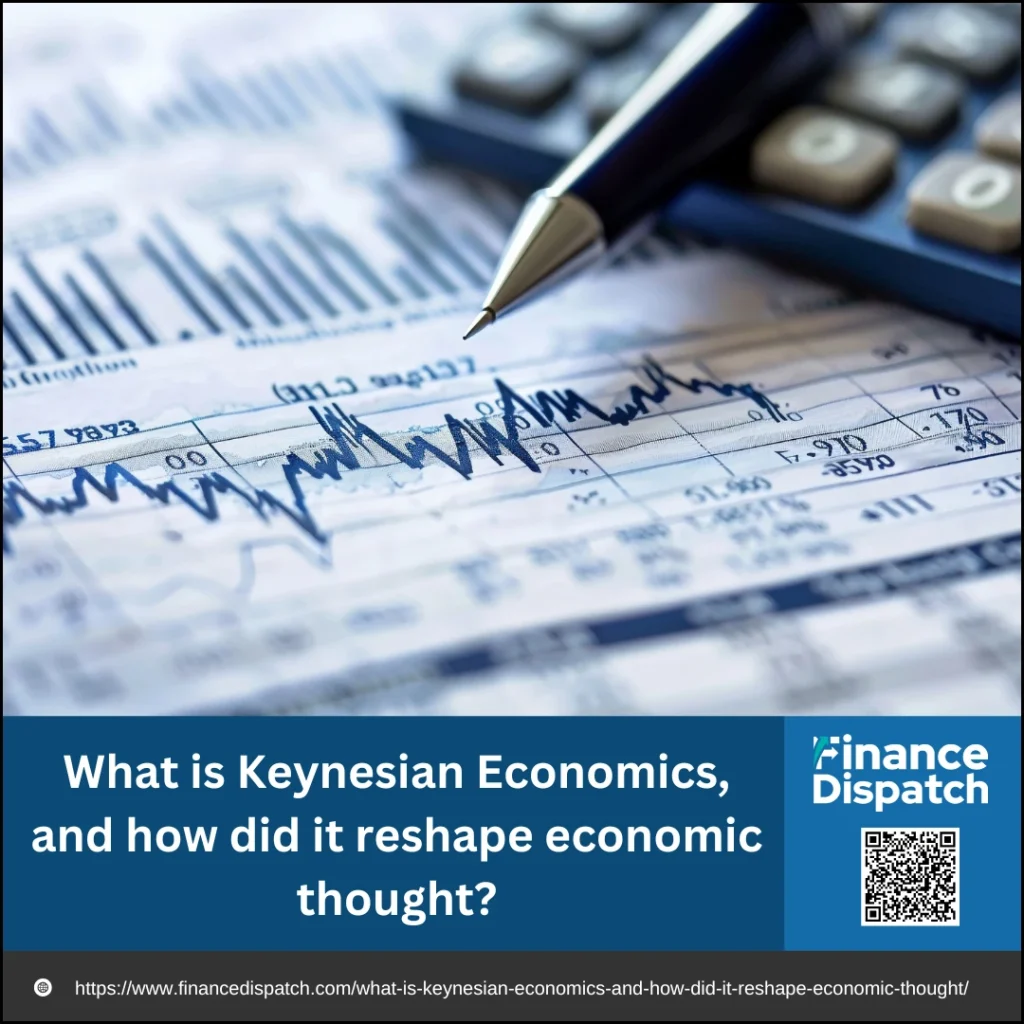Economies are complex systems influenced by a wide range of factors, from consumer spending to government policies. In times of crisis, traditional economic theories often struggle to provide immediate solutions, as seen during the Great Depression of the 1930s. It was in response to this economic turmoil that British economist John Maynard Keynes introduced a groundbreaking approach—Keynesian economics. This theory shifted the focus from the classical belief in free-market self-regulation to the idea that government intervention plays a crucial role in stabilizing economies. By emphasizing the importance of aggregate demand, fiscal stimulus, and countercyclical policies, Keynesian economics reshaped how policymakers and economists approach economic downturns and recoveries. This article explores the core principles of Keynesian economics, its impact on global economic thought, and its relevance in modern economic policies.
What is Keynesian Economics?
Keynesian economics is a macroeconomic theory that emphasizes the role of aggregate demand in influencing economic output, employment, and inflation. Developed by British economist John Maynard Keynes during the 1930s, it challenged the classical notion that free markets naturally self-correct in times of economic downturns. Keynes argued that during recessions, businesses and consumers may cut back on spending due to uncertainty, leading to prolonged unemployment and economic stagnation. To counteract this, he advocated for active government intervention, such as increased public spending and lower taxes, to stimulate demand and drive economic recovery. Keynesian economics introduced the idea that economies are not always self-regulating and that strategic fiscal and monetary policies can help maintain stability and growth, particularly during financial crises. This theory laid the foundation for modern economic policies and remains a key influence in shaping government responses to economic recessions.
The Origins of Keynesian Economics
The roots of Keynesian economics can be traced back to the Great Depression of the 1930s, a period of severe economic downturn that saw widespread unemployment and a dramatic decline in industrial production. Traditional classical economic theories, which argued that markets would naturally self-correct through supply and demand, failed to provide effective solutions. Observing this failure, John Maynard Keynes introduced a revolutionary perspective in his seminal work, The General Theory of Employment, Interest, and Money (1936). He argued that aggregate demand—the total spending by households, businesses, and the government—was the key driver of economic activity and that, during economic downturns, insufficient demand could lead to prolonged recessions. To counteract this, Keynes advocated for government intervention, including deficit spending and public investment, to boost demand and stimulate job creation. His ideas marked a fundamental shift in economic thought, paving the way for modern macroeconomic policies that emphasize active government roles in managing economic cycles.
 Key Principles of Keynesian Economics
Key Principles of Keynesian Economics
Keynesian economics revolutionized the way economists and policymakers understand economic cycles and government intervention. At its core, this theory, developed by John Maynard Keynes, emphasizes the importance of aggregate demand in driving economic growth and employment. Unlike classical economic theories that focus on supply-side mechanisms, Keynesian economics argues that fluctuations in demand can lead to recessions, requiring active government policies to stabilize the economy. Below are the key principles of Keynesian economics that define its approach to economic management.
1. Aggregate Demand Drives Economic Growth
Keynesian economics asserts that the total spending in an economy—comprising consumer spending, business investment, government expenditure, and net exports—determines overall economic output and employment levels. When demand is low, economic activity slows, leading to unemployment and stagnation.
2. The Importance of Government Intervention
During economic downturns, Keynes argued that governments should step in to boost demand through fiscal policies, such as increasing public spending and reducing taxes. This intervention helps to stimulate business activity and create jobs.
3. The Multiplier Effect
The Keynesian multiplier suggests that an initial increase in spending—whether by the government, businesses, or consumers—creates a chain reaction of increased economic activity. For example, government spending on infrastructure projects generates jobs, leading to higher household incomes and more consumer spending, further fueling economic growth.
4. Short-Run Economic Focus
Keynesian economics prioritizes short-term policies to address immediate economic challenges like recessions and high unemployment. Keynes famously argued that “in the long run, we are all dead,” emphasizing the need for timely intervention rather than waiting for markets to self-correct.
5. Price and Wage Rigidity
Unlike classical economists who believe prices and wages adjust quickly to market conditions, Keynesians argue that prices and wages are “sticky” and slow to respond to economic fluctuations. This can lead to prolonged periods of unemployment, justifying the need for government action to boost demand.
6. Countercyclical Fiscal Policies
Keynes advocated for countercyclical policies, meaning governments should increase spending and cut taxes during recessions to stimulate demand and reduce spending and raise taxes during booms to prevent inflation and economic overheating.
7. The Role of Monetary Policy
While Keynes primarily focused on fiscal policy, he also acknowledged the role of monetary policy in stabilizing the economy. Lowering interest rates can encourage borrowing and investment, further supporting economic growth. However, he warned that monetary policy alone might not always be effective, especially in a liquidity trap where low interest rates fail to stimulate spending.
 How Keynesian Economics Reshaped Economic Thought
How Keynesian Economics Reshaped Economic Thought
Before the emergence of Keynesian economics, classical economic theories dominated, emphasizing that free markets would naturally correct themselves. However, the Great Depression of the 1930s exposed flaws in this assumption, as unemployment soared and economic output plummeted. John Maynard Keynes introduced a revolutionary approach that shifted the focus from supply-side mechanisms to demand-driven economic management. By advocating government intervention, fiscal policies, and countercyclical measures, Keynesian economics fundamentally altered the way economists and policymakers approach economic crises and long-term growth. Below are the key ways Keynesian economics reshaped economic thought.
1. Challenged the Classical Self-Correcting Market Theory
Before Keynes, classical economists believed that markets would always return to equilibrium without external interference. Keynes challenged this notion, arguing that in times of economic downturns, demand could remain low for extended periods, preventing recovery. His work disproved the assumption that lower wages alone would restore full employment, highlighting the need for active policy measures.
2. Emphasized the Role of Aggregate Demand
Keynesian economics shifted the focus from supply-side economics to demand-driven growth. Keynes argued that economic output and employment levels were directly tied to total spending in the economy—including household consumption, business investments, government spending, and net exports. This idea reshaped economic policies, leading governments to monitor and manage aggregate demand more closely.
3. Introduced Government Intervention as a Stabilizing Force
Unlike classical theories that saw government intervention as unnecessary or even harmful, Keynes argued that active government policies were essential for maintaining economic stability. By implementing fiscal policies, such as public works programs, tax reductions, and direct stimulus payments, governments could counteract recessions and encourage economic growth.
4. Developed the Concept of the Multiplier Effect
Keynes introduced the multiplier effect, which demonstrated how an initial increase in spending could generate a larger overall impact on the economy. For instance, government spending on infrastructure projects creates jobs, leading to higher household incomes, increased consumer spending, and greater economic expansion. This insight remains a core principle in modern fiscal policy decisions.
5. Advocated for Countercyclical Policies
Keynesian economics proposed a countercyclical approach, meaning that governments should actively respond to economic fluctuations. During recessions, governments should increase spending and lower taxes to boost demand, while during periods of economic boom, they should reduce spending and raise taxes to prevent overheating and inflation. This principle became the foundation of modern macroeconomic stabilization policies.
6. Changed the Approach to Monetary Policy
While Keynes placed greater emphasis on fiscal policy, he also acknowledged the role of monetary policy in controlling economic fluctuations. He argued that lowering interest rates could encourage borrowing and investment, helping to stimulate demand. However, Keynes also introduced the concept of a liquidity trap, where even near-zero interest rates fail to boost economic activity, making fiscal intervention necessary.
7. Inspired Post-War Economic Policies
After World War II, many nations, including the United States, the United Kingdom, and European countries, adopted Keynesian-inspired policies to rebuild their economies. This led to an era of strong economic growth, full employment, and rising living standards. Keynesian principles guided the creation of social safety nets, public infrastructure projects, and investment in education and healthcare, shaping the foundation of modern welfare states.
8. Influenced Modern Crisis Management
Keynesian economics has had a lasting impact on how governments respond to financial crises. For example, during the 2008 global financial crisis, policymakers turned to Keynesian strategies such as massive government stimulus packages, bailouts for struggling industries, and direct cash payments to sustain consumer demand. Similarly, during the COVID-19 pandemic, governments worldwide implemented unprecedented fiscal stimulus measures to prevent economic collapse, once again validating Keynesian theories in times of crisis.
Keynesian Economics vs. Classical Economics
Economic theories have long debated the best way to manage markets, growth, and employment. Classical economics, which dominated until the early 20th century, held that free markets are self-regulating and that minimal government intervention is needed for economic stability. In contrast, Keynesian economics, introduced by John Maynard Keynes in response to the Great Depression, argues that aggregate demand drives economic performance and that government intervention is necessary to manage economic fluctuations. The table below highlights the key differences between these two economic schools of thought.
Comparison of Keynesian and Classical Economics
| Feature | Classical Economics | Keynesian Economics |
| Market Self-Regulation | Believes markets naturally return to equilibrium without intervention. | Argues markets can remain in prolonged recessions without government action. |
| Role of Government | Minimal government intervention; free markets regulate themselves. | Active government role in managing demand, employment, and inflation. |
| Focus on Supply vs. Demand | Emphasizes supply-side factors (production, investment, and savings). | Focuses on demand-side factors (spending by consumers, businesses, and government). |
| Response to Recessions | Believes lower wages and interest rates will restore equilibrium naturally. | Advocates government spending and tax cuts to boost aggregate demand. |
| Wages and Prices | Assumes flexible wages and prices, which adjust quickly to restore balance. | Argues that wages and prices are “sticky”, causing unemployment and slow recovery. |
| Economic Growth Strategy | Encourages free-market competition and long-term investment. | Uses fiscal and monetary policies to stimulate demand and growth. |
| Inflation Control | Focuses on limiting money supply growth to prevent inflation. | Believes inflation can be managed through government intervention and demand control. |
| Business Cycle View | Business cycles are natural and self-correcting over time. | Recessions can be prolonged, requiring countercyclical policies to correct. |
| Policy Preference | Laissez-faire capitalism, minimal state involvement. | Active fiscal and monetary policy to stabilize economies. |
| Famous Economists | Adam Smith, David Ricardo, John Stuart Mill | John Maynard Keynes, Paul Samuelson, Joseph Stiglitz |
The Keynesian Model in Action
Keynesian economics has played a crucial role in shaping government responses to economic downturns, financial crises, and periods of stagnation. By emphasizing aggregate demand and government intervention, Keynesian policies have been used to stimulate growth, create jobs, and prevent prolonged recessions. Below are key examples of the Keynesian model in action throughout history.
- The New Deal (1930s – U.S.): President Franklin D. Roosevelt’s large-scale public works programs and social reforms helped stimulate demand and reduce unemployment during the Great Depression.
- Post-WWII Economic Boom (1940s-50s): Governments in the S. and Europe invested heavily in infrastructure and social programs, leading to rapid economic growth and job creation.
- The 2008 Financial Crisis Response: The S. and other nations implemented massive stimulus packages, including bailouts, tax cuts, and public spending to prevent a deeper recession.
- COVID-19 Economic Stimulus (2020-21): Governments worldwide provided direct payments, unemployment benefits, and business relief programs to sustain economic activity during lockdowns.
- Japan’s Long-Term Keynesian Policies: Since the 1990s, Japan has used public investment and monetary easing to combat economic stagnation and deflation.
- The European Union’s Recovery Fund (2021-Present): The EU allocated €750 billion for infrastructure, green energy, and economic modernization to stabilize post-pandemic economies.
 Criticisms and Counterarguments of Keynesian Economics
Criticisms and Counterarguments of Keynesian Economics
While Keynesian economics has played a crucial role in shaping modern economic policies, it has also been the subject of intense debate and criticism. Critics argue that Keynesian policies overemphasize government intervention, leading to unintended economic consequences such as higher inflation, national debt, and reduced private sector growth. Additionally, opponents believe that alternative economic theories, such as Monetarism and Austrian Economics, provide better solutions for long-term economic stability. Below are the key criticisms and counterarguments against Keynesian economics.
1. Excessive Government Intervention Distorts Markets
One of the strongest criticisms of Keynesian economics is that too much government intervention disrupts natural market forces. Critics argue that the economy functions best when left to free-market dynamics, where supply and demand regulate growth, prices, and employment. Artificial stimulus and government spending can create inefficiencies, leading to wasteful projects and misallocation of resources.
2. Deficit Spending Leads to Unmanageable National Debt
Keynesian policies often advocate increased government spending during recessions, even if it means borrowing money. While this may stimulate short-term growth, it can lead to unsustainable levels of national debt, forcing future generations to deal with higher taxes and financial instability. Some critics argue that continued deficit spending weakens a country’s financial position, making it vulnerable to debt crises.
3. Inflationary Risks from Increased Public Spending
One of the key risks of Keynesian economics is inflation. When governments inject too much money into the economy through fiscal stimulus, aggregate demand increases sharply, often outpacing supply. This leads to higher prices, eroding purchasing power, and in extreme cases, causing hyperinflation. Monetarist economists, such as Milton Friedman, argue that controlling money supply rather than government spending is the better way to manage inflation and economic stability.
4. Crowding Out Private Investment
When the government borrows heavily to finance its spending programs, it competes with businesses and individuals for available capital. This raises interest rates, making it more expensive for private companies to borrow and invest. As a result, government spending may reduce private sector innovation and long-term economic growth, a phenomenon known as crowding out.
5. Short-Term Focus Neglects Long-Term Economic Health
Keynesian economics prioritizes short-term economic recovery by boosting demand, but critics argue that this approach ignores long-term consequences. Constant reliance on stimulus and government intervention can prevent necessary market corrections, delaying structural reforms that could improve productivity and competitiveness in the long run.
6. Questionable Effectiveness of Fiscal Stimulus
Some economists question whether Keynesian fiscal stimulus truly leads to sustainable economic recovery. Critics point out that government spending is not always efficient, and many stimulus projects may fail to generate long-term economic benefits. In some cases, large-scale public spending results in wasteful expenditures, benefiting politically connected industries rather than boosting overall economic productivity.
7. Dependency on Government Intervention
A major concern with Keynesian policies is that they can create a cycle of dependence on government support. If governments continuously intervene in the economy, businesses and individuals may expect bailouts, subsidies, and stimulus programs rather than adapting to market conditions. This could lead to weaker private sector resilience and reduced entrepreneurial innovation.
8. Alternative Economic Theories Offer Different Solutions
Critics of Keynesianism often point to alternative economic models that focus on market-driven solutions rather than government intervention.
- Monetarism (Milton Friedman) – Suggests that managing money supply and inflation is more effective than fiscal stimulus.
- Austrian Economics (Friedrich Hayek) – Argues that market cycles are natural, and government intervention only prolongs economic downturns.
- Supply-Side Economics – Emphasizes tax cuts and deregulation to encourage business investment and productivity, rather than increasing government spending.
Modern Keynesian Economics and Its Legacy
Keynesian economics has evolved significantly since its inception in the 1930s, adapting to new economic challenges and influencing modern fiscal and monetary policies worldwide. While Keynes originally focused on government intervention through public spending and deficit financing, contemporary Keynesian economists have integrated monetary policy, inflation control, and global financial dynamics into their frameworks. Governments today use Keynesian principles to manage economic crises, such as during the 2008 financial meltdown and the COVID-19 pandemic, where large-scale stimulus packages and central bank interventions helped stabilize economies. Additionally, Keynesian theories continue to shape discussions on income inequality, unemployment, and public investment in infrastructure, healthcare, and education. Despite criticisms from free-market proponents, Keynesian economics remains a dominant force in policymaking, proving its lasting relevance in balancing economic growth, stability, and social welfare in an ever-changing global economy.
Conclusion
Keynesian economics has fundamentally reshaped economic thought by proving that markets are not always self-correcting and that government intervention can play a crucial role in stabilizing economies. From its origins during the Great Depression to its application in modern financial crises, Keynesian principles have provided policymakers with tools to manage demand, reduce unemployment, and prevent prolonged recessions. Despite ongoing debates over deficit spending, inflation risks, and government overreach, Keynesian ideas continue to influence global economic policies, particularly in times of economic downturn. As economies evolve, so does Keynesian theory, adapting to new financial challenges, technological advancements, and global economic shifts. Whether in fiscal stimulus measures, monetary policies, or public investment strategies, Keynesian economics remains a cornerstone of modern macroeconomic thinking, demonstrating its lasting impact and continued relevance in shaping the world’s economic future.



